WHAT'S NEW ACROSS THE WORLD
What's
new April 2000
What's
new July 2000
What's
new October 2000
What's
new January 2001
What's
new April 2001
What's
new July 2001
What's
new October 2001
What's
new January 2002
What's
new April 2002
What's
new July 2002
What's
new October 2002
What's
new January 2003
What's
new April 2003
| What's New ©by
Laif DeMason
Summer is upon us, and the last few months have
been interesting. Cichlid-collecting activities worldwide have been enhanced
by a gradual increase in demand over the last year. Exporters have found
new items to ship: some new species; some hard to collect species; and
some just never shipped before. Hobbyists are re-examining the hundreds
of cichlid varieties available and visiting different selections, usually
from groups that may have faded from recent popularity. The wonderful attraction
of these fascinating fishes is that there are so many different kinds and
varieties. We will always continue to try the next groups of cichlids,
and never run out of cichlids to keep! On top of this huge selection, those
cichlid groups that were once “old hat,” will roll back around and become
“new” again. Enjoy!
Here’s “what’s new” on the cichlid scene: |
Lake Tanganyika
Cichlid exports have been strong from all the usual places around Lake
Tanganyika, except Congo. Difficulties there have stemmed the flow from
there recently. Zambia has been shipping to many importers, as there is
keen competition from there, making supplies of Zambian cichlids plentiful.
One often wonders if all the same collecting sites are being visited by
the many exporters. Tanzania exporters from the north around Kigoma have
been able to increase regular supplies due to better logistics.
|
what's new: Lake Tanganyika
|

Exported from Nsumbu (Zambia), one of the many blue
varieties of Cyphotilapia frontosa is sold as “silver blue” or “fluorescent”
in name. |
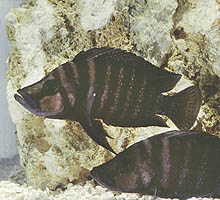
Altolamprologus compressiceps “black” can be
found in many places along the central Tanzanian (and Congo) coasts. |

Recently exported, this variety of Lamprologus
brevis, reportedly from Ikola, is a shell-dwelling cichlid. |
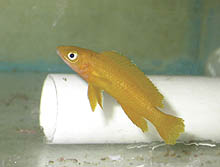
Karilani Island in Tanzania is known for a beautiful
orange-colored population of Neolamprologus leleupi. |
Lake Malawi
Shipments from Malawi and Tanzania are of good quality, as are some
items from Mozambique. Competition in Malawi has driven collectors (both
old and new) to collect and ship special fishes that are difficult to find
or are incidental in nature. Trickles of specialty items are arriving in
the United States and Europe, some not seen for many years, albeit at a
price!

From several places in Tanzania, Nyassachromis
sp.
‘blue’ are collected in the north from Itungi south to Kirondo. |

Exported seasonally, Rhamphochromis macrophthalmus
is
noted for its bright yellow ventral fins. |

From Undu Point southwards, Copadichromis sp.
“azueus midnight” may be a jumbo “Kawanga” type. |
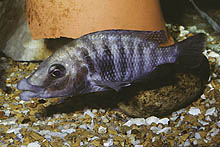
A very incidental arrival, Melanochromis labrosus
trickles
in only on the rare occasion. Photo by T. Koziol. |

Sold under different names such as Ps. “shauri”
or “black-top zebra”, this form has now been described as Metriaclima
phaeos; a male is pictured here (the female is orange-beige). |
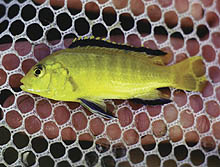
Almost never exported from the wild at Lions Cove
(Malawi), the yellow Labidochromis has been shipped! Just
think that the hundreds of thousands of yellow labidos sold previously
were all descendants of a single pair exported in the early 1980s. |
Lake Victoria
Not much news to report from the Victoria basin. There is renewed talk
from Uganda fisheries consultants about encouraging ornamental fish exports;
however, actual exports may be much farther off. Now is the time to take
stock of what varieties hobbyists do have, so when new items arrive, they
can be carefully established.
|
what's new: Lake Victoria
|

Pictured here is a small ‘Haplochromis’ species
sporting an elongate body and a red tail, collected near Jinja (Uganda)
in 1989, but never seen since. |

Exported around 1994 from Kenya but never established
in the hobby, a large, solid-gold species of ‘Haplochromis’ has
been seen by this author only once. |
Madagascar-India
Cichlids from Madagascar and India have peeked interest in many hobbyists
recently. There are several species available from specialty breeders,
and a new reference book as well.
|
what's new: Madagascar/India
|

From Madagascar, several northern populations of Ptychochromis,
including the ones from Nosy Bé, are now all considered the same
species. |

A rare chromide, Etroplus canarensis, is a
third species from the Indian subcontinent, related to the Malagasy cichlids.
Photo by J. Rapps. |
Neotropics
Supplies of New World cichlids from South American exporters and other
breeders are strong. Geophagines, dwarf cichlids, and discus seem to be
the long time favorites. The varieties from commercial sources seem to
be on the rise and consistent in availability.
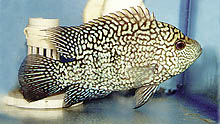
From Mexico, the Escondido variety of Herichthys
carpintis has a beautiful large-spot color pattern. Photo by
J. Rapps. |
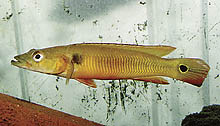
From Rio Tapajos (Brazil), a juvenile Crenicichla
sp. ‘Tapajos I’. Also called “red Tapajos pike,” the adults become
fire-engine red, and females sport a white submarginal band. Photo
by J. Rapps. |
|















